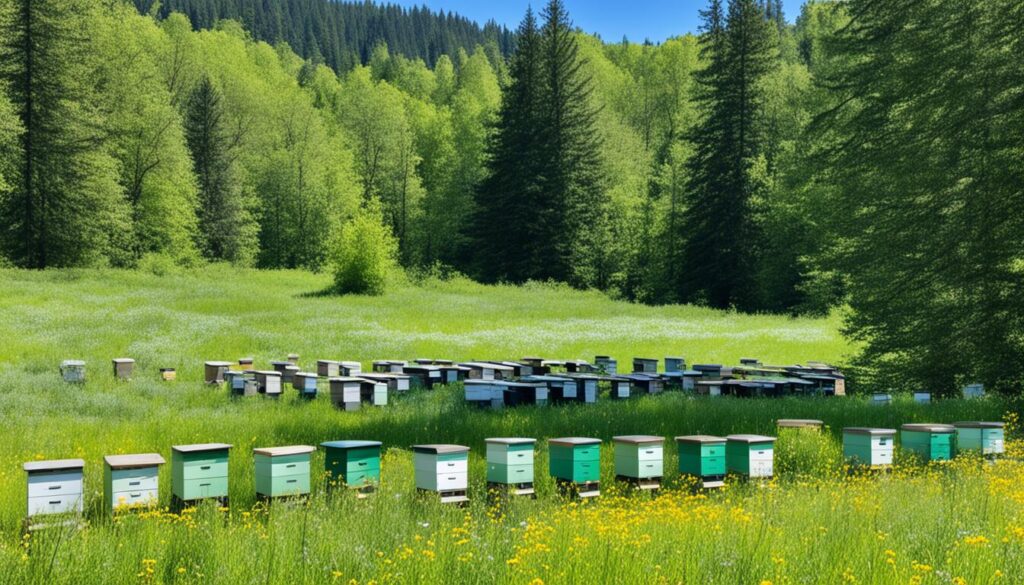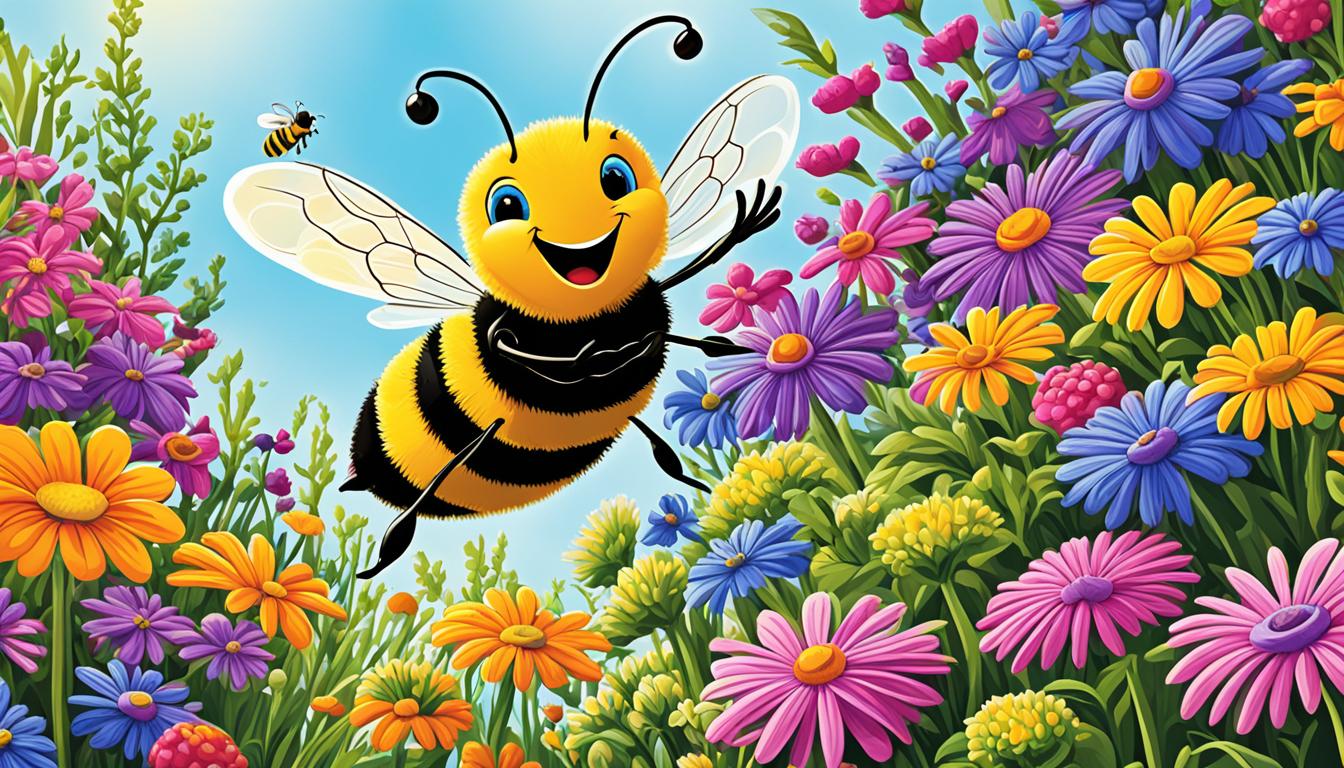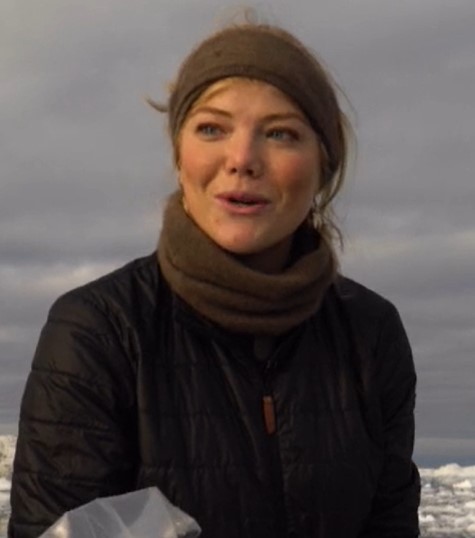Bees have been around for millions of years, playing a key role in pollinating flowers and keeping our ecosystem balanced1. But, these important pollinators are in trouble, with their numbers dropping sharply over the last century1.
Human actions like big changes in land use and the use of harmful pesticides have destroyed bee homes1. Global warming, rising temperatures, and changes in when plants bloom have also hurt bee health1.
This decline is serious because bees pollinate about 80% of flowering plants and help over 35% of global agricultural land1. If bees disappear, we could lose crops like apples, berries, avocados, coffee, and onions. This would affect food security and people’s lives all over the world1.
Key Takeaways
- Bees are crucial pollinators, responsible for maintaining the balance of our ecosystem and supporting global food production.
- Human activities, such as pesticide use and habitat destruction, have contributed to a significant decline in bee populations.
- The extinction of bees would have far-reaching consequences, including the reduction of food supplies for essential crops.
- Sustainable farming practices, such as organic agriculture, can help support bee populations and promote a healthier environment.
- Individuals can take action by creating bee-friendly gardens, buying local honey, and supporting conservation efforts.
The Importance of Bees and Their Role in Pollination
Bees have been working with flowers for millions of years. They have special features like pollen-carrying pouches. These help them move pollen from one plant to another, which lets over 80% of the world’s flowers reproduce2.
Bees and plants work together, which is key for our food. Bees pollinate more than a third of the food we eat, says the Food and Agriculture Organization (FAO) of the United Nations2. Over 20,000 bee species are the top pollinators, helping keep ecosystems healthy and supporting food security2.
Bees’ Coevolution with Flowering Plants
Bees and flowers have changed together over time. Bees have gotten better at pollinating different plants. And plants have changed to attract bees better. This relationship is key for bees and plants to survive and reproduce2.
Bees’ Contribution to Global Food Production
Bees are crucial for growing many fruits, vegetables, and crops we eat. In the U.S., honey bees add $15 billion to $20 billion a year to our food3. Without bees, our food supply would be much smaller, as they pollinate about one-third of the world’s crops3.
But, bee numbers are going down because of habitat loss, farming, climate change, and pesticides2. This is a big worry for our food and ecosystems2.
“Bees are the foundation of our food systems and the health of our ecosystems. Without bees, our world would be a very different place.”
Reasons Behind the Decline of Bee Populations
Bees are vital for our ecosystems, but their numbers are dropping fast. This decline is due to pesticides, losing their homes, and climate change4.
Pesticide Use and Its Impact on Bees
Pesticides, especially neonicotinoids, harm bees a lot. They mess with bees’ nerves, making it hard for them to feed, forage, and reproduce4. These chemicals also lower bees’ chances of breeding and make them more likely to get diseases4.
Habitat Loss and Fragmentation
Bees are losing their homes because of habitat loss and fragmentation. Intensive farming and removing natural habitats like meadows and trees cut down on food and homes for bees4
This has put many wild bee species at risk of disappearing, with nearly 1 in 10 in Europe facing threats4.
Invasive species like the Asian Hornet and the Small Hive Beetle also harm native bees, upsetting the balance of nature4. Habitat loss, climate change, pesticides, pests, and diseases have all hit bee populations hard, making it tough for them to survive4.
“The combination of habitat loss, climate change, pesticides, pests, and diseases weakens bee populations and other pollinating insects, making survival challenging.”
We need to tackle the many reasons why bees are disappearing. Understanding the problem fully is key to protecting these important pollinators456.
Bees Are at Risk of Extinction
Bees, vital for our ecosystems and food, are facing a high risk of extinction. Over the past 300 years, many bee species have declined. Eight species of bees have officially been declared as endangered, including seven Hawaiian yellow-faced bees and the rusty patched bumblebee7.
Endangered Bee Species
The loss of bees is a global issue. More than a quarter of North American bumblebee species are threatened with extinction8. The American bumblebee has vanished from at least eight states. The Southern Plains bumblebee has become much rarer and is missing from six states8. The Mojave poppy bee, found in just seven places near Nevada’s Lake Mead, is also at risk8.
Consequences of Bee Extinction
Bees going extinct would be a disaster, causing ecosystem collapse and a global food crisis. About 80% of flowering plants and 35% of global crops rely on pollinators, with bees key among them7. Losing bees would be severe, as over 40% of pollinator species (bees and butterflies) could face extinction soon9.
Without bees, our ecosystems would collapse, threatening food for billions worldwide7. This crisis needs urgent action and global focus to save these crucial pollinators and protect our planet789.
Practical Ways to Help Save the Bees
As threats to bees grow, we must act to support these vital pollinators. Simple changes in our daily lives can make a big difference in saving the bees10.
Support Organic Farming
Supporting organic farming is a key way to help bees. Organic farms don’t use harmful pesticides, which are bad for bees10. Choosing organic products helps bees and is good for the planet10.
Create Bee-Friendly Gardens
Creating bee-friendly gardens helps bees too. Planting flowers with lots of nectar feeds bees well11. Leaving some areas wild gives bees places to nest and live12.
Don’t use harmful pesticides in your garden. Pesticides like neonicotinoids are still okay for home use but are bad for bees11. Avoiding these chemicals protects bees and other good bugs.
Building bee hotels is another good idea. These give solitary bees a place to nest and are easy to add to any garden12.
Supporting local beekeepers also helps bees. Beekeepers keep bees healthy and support nature. Buying honey and bee products from locals helps these efforts12.
By doing these things, we can help ensure a good future for bees. They are crucial for our world101112.
The Role of Honey Bees in Bee Conservation
Honey bees are not at risk of going extinct, but they can sometimes harm native bees. They are “managed bees” because beekeepers take care of them. Native bees, on the other hand, are wild and play a key role in nature13.
A single hive of honey bees can have tens of thousands of bees. This can crowd out wild bees for food13. In just three months, a hive can collect as much pollen and nectar as 4 million solitary wild bees, which can hurt their numbers13. Honey bees can also spread diseases to native bees, like deformed wing virus and Crithidia bombi13.
In the United States, the number of honey bee colonies has gone up and down but overall has increased14. But, too many hobbyist bee hives have pushed native pollinators out, hurting their numbers14. Native pollinators, including bees, moths, butterflies, hummingbirds, bats, and beetles, are also crucial for pollination14.
To help bees, we should focus on protecting native bees. Planting native trees, shrubs, and perennials is key to supporting local pollinators.14 Providing food, shelter, water, and nesting areas for pollinators is important.14 Avoiding pesticides is crucial for pollinator health.14
| Key Differences | Honey Bees | Native Bees |
|---|---|---|
| Population Size | Tens of thousands per hive | Typically smaller populations |
| Habitat | Managed, controlled hives | Natural, unmanaged habitats |
| Impacts | Can outcompete and spread diseases to native bees | Play crucial roles in pollination but face decline |
| Conservation Approach | Focus on maintaining managed hive populations | Focus on protecting and enhancing natural habitats |
Understanding honey bees’ role in conservation helps us support native bees better131415.
“Bees are essential for pollinating many fruits, nuts, and vegetables, impacting food security.”15
Raising Awareness and Supporting Bee Conservation Efforts
World Bee Day, on May 20th, is a global event to highlight the importance of bees16. The Food and Agriculture Organization of the United Nations (FAO) leads this day. It focuses on bees’ key role in our ecosystem and food supply.
Every year, World Bee Day has a theme to engage people worldwide. In 2024, it’s all about “Bee engaged with Youth,” focusing on young people in beekeeping and conservation17. This aims to train the next bee advocates and protectors for the future.
Supporting World Bee Day and bee conservation is easy in many ways. Helping local beekeepers is a big step. They are key in raising bee populations and teaching their communities16. Beekeepers not only offer quality honey but also spread bee knowledge and motivate others.
World Bee Day Initiatives
World Bee Day has many ways for people to join in. You can:
- Join bee-themed events like walks, workshops, or educational programs
- Sign petitions to support bee conservation
- Use the #WorldBeeDay hashtag on social media
- Volunteer with bee protection groups
Supporting Local Beekeepers
Buying honey directly from local beekeepers helps bee conservation16. It supports beekeepers and spreads bee awareness in communities17. Beekeepers also offer programs to teach people about bees and their ecosystem role.
By joining World Bee Day events and backing local beekeepers, we help protect bees and our planet17. Together, we can keep these vital pollinators safe and ensure they continue to support our ecosystems.

The Importance of Native Bees and Bee Biodiversity
Honey bees are great for pollinating certain crops, but native bees are often better at it. They have evolved to work with the plants in their areas. This makes them key for keeping ecosystems healthy and food production stable. Different bees pollinate different plants, so having many bee species is important.
In the United States, there are 4,000 different native bee species18. These bees add over $5 billion in crop pollination services each year18. In fact, bees help pollinate 70 out of 100 crop species that feed most of the world’s people18. But, some harmful pesticides are banned in the European Union, not in the U.S18..
Having many bee types is key for our food and nature19. About 30-50% of all native bees need certain plants to survive19. Losing these plants hurts the bees. With 20,000 bee species worldwide and 4,000 in the U.S.19, keeping bees diverse is crucial.
Native bees are better at pollinating native plants and are vital for ecosystem health20. Studies show that wild and managed bees do about the same for crops20. Some rare bees pollinate up to 86 percent in certain places20. Yet, a survey from 2006 to 2015 found a 24% drop in bee species from before 199020.
We need to protect native bees for our food and nature. By understanding their role and how they work with plants, we can help these important pollinators.
| Statistic | Value | Source |
|---|---|---|
| Number of native bee species in the United States | Over 4,000 | 18 |
| Value of crop pollination services provided by native bees in the United States | Over $5 billion | 18 |
| Percentage of crop species that require bees for pollination | 70 out of 100 | 18 |
| Percentage of the world’s population that is fed by these 70 crop species | Around 90% | 18 |
| Percentage of native bees that are highly specialized | 30-50% | 19 |
| Total number of known bee species globally | Over 20,000 | 19 |
| Number of native bee species in the United States and Canada | 3,600 | 20 |
| Percentage of flowering plants that depend on insect pollinators | More than 80% | 20 |
| Percentage of global crop production that relies on pollinators | One-third | 20 |
| Estimated annual production value attributed to wild bees | Over $1.5 billion | 20 |
| Percentage decline in bee species compared to pre-1990 tallies | 24% | 20 |
Addressing Underlying Causes: Habitat Loss and Pesticide Use
To protect bees, we must tackle habitat loss and pesticide use head-on. This means restoring habitats, controlling harmful pesticides, and supporting sustainable farming. Everyone, from governments to individuals, has a role in making this happen.
Restoring bee habitats is vital. The Xerces Society has collected over 14,000 bee sightings from all over the U.S. and Canada21. By fixing bee homes, we can stop the loss of habitats that harm bees.
Controlling pesticides is also key. The rusty-patched bumble bee faces threats from diseases, habitat loss, and pesticides21. The Xerces Society has called for stricter rules on harmful insecticides21. This can protect bees from pesticides.
Supporting sustainable farming is crucial too. In the U.S., bees add $20 billion to our food and related industries22. Most of our food crops rely on bees and other pollinators22. By farming better, we can help bees and keep our food systems strong.
We need everyone to work together. Governments should push for more bee-friendly policies. People can help by making gardens for bees and backing local beekeepers. Fixing bee problems is a team effort.

“Honey bees are critical pollinators, and understanding how they respond to stressors and finding ways to improve their resilience is essential for agriculture and ecosystems.”22
The Penn State Center for Pollinator Research focuses on bee health and conservation22. Christina Grozinger won a big award for her bee research at Penn State in 202122.
By tackling habitat loss and pesticide use, we can help bees and protect our ecosystems and food. This is a big task, but we can do it together. The fate of bees affects our environment and our food212223.
Shifting Perspectives: Rethinking Our Relationship with Pollinators
The decline of bees is a clear warning, showing how our actions harm nature24. We need to see how vital bees are for life on Earth and our health25. By changing how we see nature, we can help save these crucial species.
Bees and other pollinators are key to our connection with nature and the services they offer24. They help pollinate a third of the food we eat worldwide26. But, they face threats like climate change, losing their homes, and harmful chemicals26.
We must value pollinators and understand how all life is connected25. By valuing bees, we can work together to protect their homes, stop harmful actions, and fix the problems they face24.
Bees and pollinators are linked to our health and well-being26. Without them, our food and ecosystems could suffer greatly26. By changing how we see nature, we must protect these vital species for a better future242526.
Conclusion
The struggle of bees is a big deal for human food security and the health of our planet27. By working together on bee conservation, environmental protection, and getting the whole community involved, we can help save these important pollinators28.
Studies show that bees, both domestic and wild, are in trouble. This could really hurt our food supply29. Without bees, many crops we need to eat would drop in production. This could lead to higher food prices, less food, and even hunger27. We need to act fast, as the fate of bees and our planet is uncertain.
We can help bees by using farming methods that are good for them, making places for them to live, and spreading the word in our communities28. If we work together, we can make a world where bees and humans live well together. This will keep our ecosystem healthy for the future.
FAQ
How important are bees to the ecosystem and food production?
What are the main threats to bee populations?
Which bee species are at risk of extinction?
What are the consequences of losing bees?
What can individuals do to help save the bees?
How do honey bees and native bees differ in their roles?
What is World Bee Day and how can people participate?
How can we address the underlying causes of bee decline?
Source Links
- Why are bees endangered and what happens if they go extinct? | FairPlanet
- Why bees are essential to people and planet
- How you can keep bees from becoming endangered
- What are the causes of bee decline? | Friends of the Earth
- Save the Bees
- Honey bees are not in peril. These bees are.
- Native Bees
- Want to Save the Bees? Focus on Habitat, Not Honey Bees
- 17 Ways You Can Help Save the Bees – The Best Bees Company
- Five easy ways you can help save bees | Greenpeace UK
- Our tips on how to bee friendly
- The Truth About Honey Bees
- Are Honeybees in Danger of Extinction?
- The Bee Conservancy – Est. 2009 in Response to the Bee Crisis
- Save The Bees
- World Bee Day | United Nations
- Bee is for Biodiversity
- Does the loss of plant diversity affect the health of native bees?
- The underappreciated benefits of wild bees
- Threats & Conservation Efforts
- Protecting Honey Bees and Other Pollinators
- Threats to Pollinators | U.S. Fish & Wildlife Service
- Be(e)coming pollinators: Beekeeping and perceptions of environmentalism in Massachusetts
- Do we need Artificial Pollination if we have Multispecies Justice in the Anthropocene?
- Untitled Document
- Mountain Journal
- CAHFS Weekly Topic: Bee decline – A great concern for US food security

